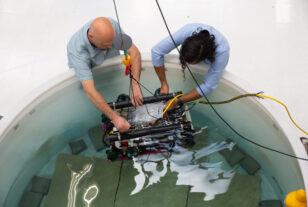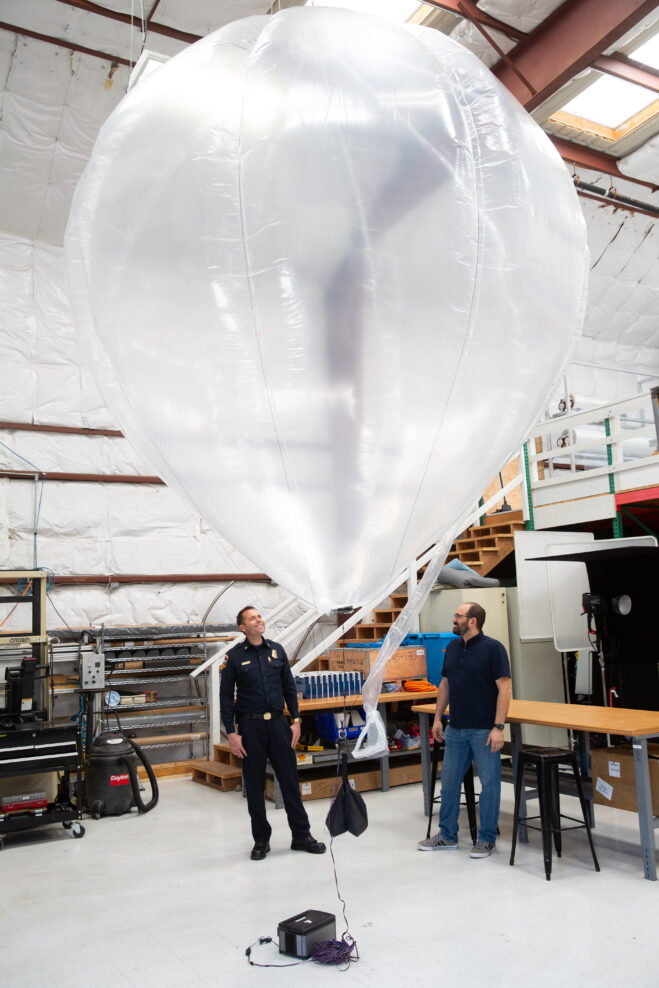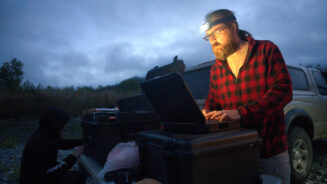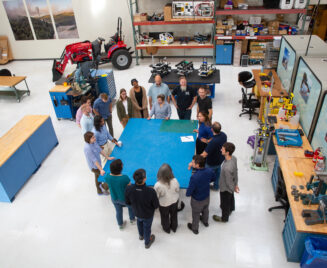Designing Technology for Environmental Resilience

- One Good Machine venture, Reefgen, has created a remotely operated underwater robot that can replant coral and seagrass far faster and cheaper than human divers, helping to slow the destruction of the earth’s vital coral reefs, half of which have disappeared in the last 30 years.
- Repurposing technology originally developed for internet connectivity, Good Machine is partnering with CAL FIRE to deploy high-altitude balloon-based detection systems that can spot wildfires as soon as they begin – by night, in poor weather, and through heavy cloud or smoke cover – and relay information in real time to firefighters.
I have seen the greatest impact from my philanthropy when I have supported organizations led by brilliant social entrepreneurs focused on innovative and timely solutions that can be measured and scaled.
In late 2019, Dave Solomon—a Bay Area-based tech entrepreneur and self-described “telecom nerd”—founded Good Machine, a venture studio that develops new technologies and incubates companies for the common good, especially in areas of environmental resilience.
The premise was simple: Good Machine would look for urgent, large-scale environmental challenges in need of a solution. Technologies to address those problems would then be developed, tested, and proven in a short timeframe, scaled up, then spun off into—ideally—profit-making start-up companies.
From its large, airy makerspace in the Bay Area, filled with enthusiastic engineers and scientists, Good Machine develops creative approaches to pressing global challenges, often leveraging and repurposing technology built and abandoned by other companies.
At Good Machine we build companies that the world needs. If we’re building underwater robots, it’s because the world needs to be able to plant coral faster than it historically has been able to do. So we’re mechanizing agriculture underwater and nobody else is doing it. The balloons are another example of how you can take a failed startup... and repurpose it for public good.
Focusing on environmental issues that grow more urgent every year, Good Machine began by taking on one of the largest and most important challenges to the planet’s future: the disappearance of the world’s coral reefs.
Coral reefs are crucial to earth’s marine ecosystem, providing protective nurseries for fish and barriers against wave damage. Covering less than 1% of the planet’s surface, they are home to 25% of life in the ocean. But over the past three decades, the impact of rising temperatures and pollution has taken a dangerous toll. Nearly half of all the coral reefs in the world have disappeared, and within another 17 years, an estimated three-quarters of the remaining reefs will be gone. Nearly 2.5 acres are disappearing every minute.
The good news is that coral reefs can be replanted; the bad news is that replanting by hand, as is the current practice, is slow and expensive. An experienced diver can plant a few hundred corals a day. At that rate, the coral lost in a single minute would take a decade to plant back.


To address the problem, Good Machine has created a new company, Reefgen, to develop a remotely operated underwater vehicle (ROV) that works far faster and for longer periods than human divers. Tethered to the surface by cable, the ROV drills holes in existing coral and quickly attaches new coral to build a reef. Having successfully tested its prototype and planted corals in the waters of Oahu, in Hawaii, Reefgen is scaling up for large-scale production and shows promise as a new path forward in the restoration of the world’s coral reefs.
25%
Of ocean life supported by coral reefs, compared to the 1% of the earth’s surface they cover
~50%
Of all the coral reefs in the world have disappeared in the past 30 years
100x
Speed up to which Reefgen’s underwater robots can plant coral compared to the most experienced human divers
Having looked beneath the sea to address one challenge, Good Machine is turning in the opposite direction—up into the air—to solve another.
Each and every year, massive wildfires in California destroy 4% of the state’s entire land mass – more than 6,500 square miles. Beyond their direct and immediate devastating impact on people, livelihoods, and animals, the blazes cause untold long-term environmental and health damage.
4%
The State of California possesses one of the largest and formidable firefighting capabilities in the world—a dedicated army of people and resources known as CAL FIRE. But even the most advanced firefighters can’t contain wildfires if they aren’t aware of them before they grow from manageable blazes into uncontrollable “mega-fires.”
Solving Urgent Global Issues with Technology
Fire’s a very real threat. I’ve seen the devastation firsthand. And some things are lost forever. While we try to reduce it, it’s a threat that’s going to be ever-present.
To address the problem, Good Machine created a new company, called Balloon Tech, adapting technology from equipment Google developed earlier for a telecom platform called Project Loon. “It just happens that the high-altitude balloon platforms that Project Loon designed and built are ideally positioned for detecting fires,” Solomon observes. “We have the ability to stay in the sky for a long period of time. We can carry a lot of payload. We have communications—just think of us as a fire tower in the sky, looking straight down instead of watching to the horizon.”

The system is simplicity itself. Gigantic plastic balloons filled with helium—“the fanciest garbage bags you’ve ever seen,” says Solomon—are launched to an altitude of about 15 miles, where they can remain, focused exclusively on detecting the first signs and ongoing growth of fires, for as long as six months. The balloons are equipped with a solar power array and onboard computers, sensors, and thermal cameras to survey large tracts of land and detect where the ground is too hot, indicating a fire. “So you don’t need to do the hard work of figuring out, is this white puffy thing you’re looking at smoke or a glacier,” Solomon notes. The balloons can carry out their detection work 24 hours a day, through smoke, clouds, and night, and offer several advantages over the NASA and NOAA satellites currently in use, including higher resolution and the ability to linger in place as long as needed.
Onboard computers process the data, generate alerts, and send the information via satellite link to Good Machine’s “mission control,” where a systems provider alerts CAL FIRE in real time. Balloon Tech’s devices then remain on the job, carrying out damage assessments to help CAL FIRE manage its resources. “You generally have the greatest chance of success fighting a fire in its earliest stages,” notes CAL FIRE Deputy Chief Marcus Hernandez. “The earlier we detect, the sooner we can get resources there.”

Buoyed by its initial success with the initiative, Solomon now foresees utilizing balloons to provide coverage for the most at-risk areas of California and beyond, with the system then expanding for deployment in other parts of the country and around the globe.
By knowing what’s on fire where and spotting it early, we can help the American West make megafires a thing of the past.
Despite the scale and significance of the problems they look to solve, Good Machine’s new companies face the same hurdles as any start-up looking to raise capital to test, implement, and then scale up its concept.
That’s where Griffin Catalyst stepped in. Compelled by the promise of Good Machine’s creative yet practical new approaches to conservation and resilience challenges, Griffin Catalyst provided crucial early funding that allowed Good Machine to develop novel ideas into companies.
Our relationship with Griffin Catalyst has been fantastic. Our priorities…are almost exactly the same. We’re both looking to solve the world’s hardest problems in the shortest period of time and we’re trying to do it in the most cash-efficient way so that we can do as much as possible. They understand what we’re trying to build and they’ve been super-helpful in making it happen
When it was founded, just five years ago, Solomon envisioned Good Machine building two or three new companies a year. Today, with support from Griffin Catalyst, the company is looking to help more than a dozen companies develop and scale. “We’ve grown from three people to 30 people,” said Solomon. “We’ve outgrown three facilities in the process. We’ve built what we’ve built because we have 10 lifetimes’ worth of work to do to help the planet. And there just isn’t enough time. So we need to do everything at once and tackle all the problems that we’re set up to solve.”


